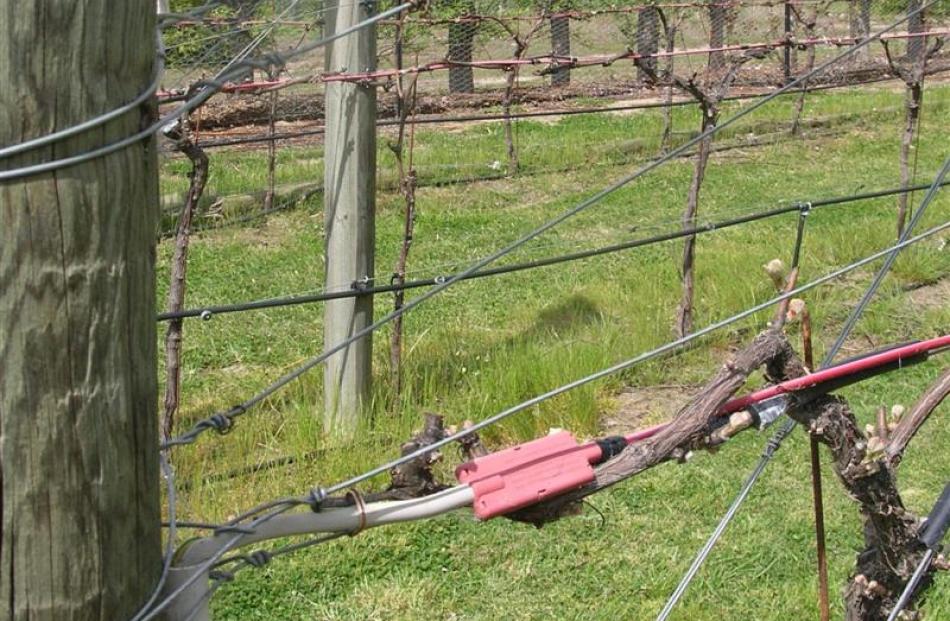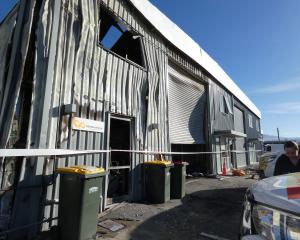Traditional frost-fighting methods can be labour and cost-intensive or environmentally disruptive, so some Central Otago growers are seeking new ways to protect fruit and nuts. Rosie Manins talks to three growers in the Cromwell basin trialling alternative frost-fighting techniques.
Walnut and almond grower Otto Muller is once again putting his brain to work in the fight against frost damage to vulnerable crops.
Hailing from Switzerland, Mr Muller introduced the method of using water to protect his and many other growers' crops in Central Otago about four decades ago.
Now, he is using water in a different way on his Pearson Rd property by combining it with hot air and high-powered fans.
Mr Muller has designed and built a contraption which disperses warm air over his nut trees, although unlike traditional heat-based frost-protection methods, the warm air stays low around trees instead of immediately rising into the atmosphere.
By shooting water into a furnace burning wood and other vegetable matter, Mr Muller is able to combine moisture with hot air, making it heavier than cold air.
The warm, humid air is then sucked into a giant tractor-powered fan connected to the furnace, and blown out over crops.
Mr Muller said a rack in the furnace meant water did not extinguish the burning wood below.
"At this stage it's just a set-up to calibrate the three factors of air, moisture and heat. Once I have the combination right, I will use pipes and an engine on the device so it can be placed in the middle of a paddock and disperse the moist, warm air through a rotating pipe across the entire area," he said.
Eventually the warmth of the air would fade, but if applied to trees every few minutes, it would be enough to prevent frost damage, he said.
The benefits of his latest idea include the abundance of wood and other vegetable matter on rural properties - which is normally burned anyway - and the fact potentially polluting fuel particles settle to the ground when moisture is applied to emissions.
Heat treatment
Also using heat to prevent frost damage on grapevines is Cromwell electrician and recreational grape grower Duncan Sangster.
He has become involved with others who adapted a system, originally trialled in France in 1996 by French company Deleage, as a way to heat grapevines to ward off frost.
Designer Climate Systems Ltd teamed up with international heating-cable manufacturing heavyweight DEVI - which had since purchased Deleage - and Danfoss Heating Division.
The result was a heating cable installed in vineyards and used as an element along wires around which vines were trained.
Mr Sangster is a partner of the New Zealand company and has installed the system in vineyards throughout the Cromwell basin for the past ten years.
"It's quite simple - when the temperature drops the element automatically turns on and protects the plant," he said.
The system has been effective in temperatures down to -6degC.
On small properties the system is connected to electricity mains, while on larger blocks of land it can be run by generators.
Mr Sangster said the self-limiting device would not overheat the vines, and turned itself off when temperatures stabilised.
He said the system was popular in Central Otago because it was not obtrusive in the landscape.
Snow guns
Snow is not usually considered a benefit to fruit growing, but Big Picture Wine Adventure and Restaurant co-founder and owner Phil Parker is using snow-making machines to his advantage.
With only 2ha of Pinot Noir vines at Cromwell, most frost-fighting methods are too costly for Mr Parker to bother with.
After being "nailed" by frost last spring, he was in the market for a cost-effective way to protect his small vineyard.
An opportunity arose for him to trial redundant snow-making machines from the nearby Coronet Peak and Remarkables skifields.
Mr Parker's two loaned snow guns act as high-powered air fans, circulating air around the vines to prevent frost from settling.
"There's a bit of irony in the fact I'm using snow-making machines to fight frost."
Conventional wind machines were cost-effective for about 7ha vineyard blocks, and the use of helicopters was even more expensive, he said.
By using a diesel-powered generator for the two snow guns, he could afford to flip the switch when temperatures dropped.
"We are just trialling them this year, with a view to purchasing them and maybe encouraging other vineyards to do the same.
"As far as I know, the secondhand snow guns have never been offered for sale to individuals, so I don't know the exact cost involved, but once they are bought, the cost [of frost-fighting] would just be power and any maintenance," he said.
The machines blow out air at 100kmh and can stimulate air movement up to 100m away.
Mr Parker is hoping to put them to use a few times before summer starts so he will know whether they are indeed an effective tool in the fight against the Central Otago cold.













